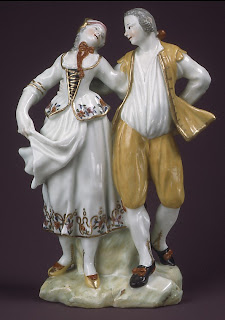Dance is a type of art that can be used and interpret in many ways. It’s a form of releasing stress, a form of entertainment, of joy, sadness, and in some cases of pain. For me, dance is spiritual and also a way of escaping, when life gets a bit hectic. I escape through spiritual dance; I worship and give praise to my Lord and savior Jesus Christ. In doing this I am able to escape the craziness of life, even if its only for a few minutes. Dancing is a beautiful feeling, this is why I wanted my exhibit to represent dance and its different usage.
There are three artworks from my exhibit that really sum up what my collection is all about. These three artworks represent the different sections in which they came from; Asian Art, European Paintings, and European Sculpture and Decorative Art. These artworks not only share a similarly of dance but also of movement. The artworks were all made to look as if they were in motion. The first artwork in my exhibit is “Dancers, Pink and Green” by Edgar Degas; other then it being my favorite artwork out of the entire collection, it is a very beautiful painting. It reminds me of my friend Lesley, she was a dance instructor for teenagers. It was her first time ever conducting a play. She was short of staff so she asked for my assistance in helping with the costumes.
As I walked backstage, I saw a bunch of young girls running back and fourth getting accessories for their costumes. Other girls were waiting on the side line for their cue, and some fixing their hair and talking just like in Degas painting. The artist painted young girls putting on the finishing touches to their costumes to what seems to be a play. The other two artworks, “Shiva as Lord of Dance (Nataraja)” and “The Genius of the Dance” by Jean-Baptiste Carpeaux both have jumping movements as if hoping from one leg to another. I feel like one of the many meanings of these artworks is to catch the viewers attention by using body movements; which is why all of the artists have their artworks look as if in motion.
Edgar Degas
“Dancers, Pink and Green”
1890
European Paintings
Jean-Baptiste Carpeaux
“The Genius of the Dance”
1872
European Sculpture and Decorative Arts
“Shiva as Lord of Dance (Nataraja)”
880-1279
Asian Art
Prince Paul Troubetzkoy
“Dancing Girl”
20th Century
European Sculpture and Decorative Arts
“Dancing Ganesha”
10th Century
Asian Art
Edgar Degas
“The Dance Class”
1874
European Paintings
Giovanni Domenico Tiepolo
“A Dance in the Country”
1755
European Paintings
Edgar Degas
“The Dancing Class”
1870
European Paintings
Capodimonte
“Dancing Couple”
1755-59
European Sculpture and Decorative Arts
Edgar Degas
“Russian Dancer”
1899
European Paintings
Edgar Degas
“Dancer with a Fan”
1890-95
European Paintings
“Dance Wand (Bair)”
Late 19th -early 20th century
Arts of Africa, Oceania ant the Americas
Hubert Robert
“The Dance”
1733-1808
European Paintings
Pierre Monier
“Shepherds and Shepherdesses Dancing from a set of Mythological Subjects after Giulio Romano”
1639-1703
European Sculpture and Decorative Arts
Eadweard Muybridge
“Dancing Waltz”
1883-86
Photographs






























